Archive for May 2010
Mother’s Day
My first piece published in The Haitian Times.

On Mother's Day, Cherline Augustine shows a picture of her one-year old son Jounary, killed in the earthquake. (Photo by Alice Speri)
Though Lebrun’s younger sisters and brother survived, the Lebrun family didn’t celebrate Mother’s Day this year.
“It’s a sad day and we don’t have the means to celebrate anyway,” said Guideland, holding her remaining children close around her. The family’s home was looted in the days after the earthquake and all their belongings were lost, including their only photos of Nadine.
“Nadine helped me with everything in the house,” her mother added. “Her siblings ask about her everyday when they come home from school.”
On Mother’s Day, Haitians would traditionally wear a red flower on their shirt if their mother is alive, or a black one, if she passed away. With over 230,000 dead in the earthquake, the number of orphaned children who would wear black flowers and of mothers who would have no child left to wear a red flower in their honor balances out, but very few wore any flowers at all today.
In a city where one of the first questions children ask when they meet you is whether your parents are still living, every corner is home to an orphan or a mother who lost her child.
A block away from the Lebrun family, sisters Woodline and Cherline Augustin each lost their only son, three year-old Jamley and one year-old Jounary, the first killed while visiting a relative’s house and the second crashed under his two-storey home. It took Cherline Augustin almost a month to get his little body out of the rubble, she explained, holding onto a picture of her son a photographer took on his first birthday, while her sister cried silently holding a friend’s baby.

The Augustine sisters each lost their only son in the earthquake. They now live in what used to be the second floor of their building, but is now the ground level, in the same house where one of their children was killed and in spite of government recommendations that the building is unsafe. (Photo by Alice Speri)
Very thin and wearing matching pink shirts, the two sisters looked like little more than children themselves. They lost their own mother before the earthquake and live alone in what used to be the second floor of their building, but is now the ground level. Neither is married or has a job, and though they would both like to have other children in the future, they say they can hardly sustain themselves.
The first Mother’s Day since the January earthquake, Sunday was a sad day everywhere in Port-au-Prince. Though local radios still dedicated songs to mothers and some celebrated the recurrence with flowers and gifts, the mood was all but festive.
The mothers and children killed on January 12 were remembered in churches and with moments of silence. Others chose to dedicate this day to the mothers and children who survived the earthquake but live in dire conditions.
Among them was Tanya Lemaire. The 30-year old pastry chef left her six year-old son home today.
“It’s Sunday, I have to go feed the other kids,” she told him.
Every Sunday since last Easter, Lemaire and a group of friends from Petionville have been cooking upwards of 400 hot meals and driving them to the Boston neighborhood of Cite’ Soleil, where they distribute the food to children, together with footballs and soft drinks.
Today, for Mother’s Day, the group decided to include mothers in the distribution, though the idea caused tensions in the neighborhood and fights erupted among the crowd of mothers gathered around the meal packets, while many children were left behind.
“I hate to say it but the problem are the adults,” Lemaire said. “Children know how to stay in line, hand in their tickets and take their meal. We wanted to give mothers something to celebrate with, but I don’t think we managed to do that.”
While for many, from Nazon to Cite’ Soleil, this year’s Mother’s Day was just one more difficult day in Haiti, some decided to share this somber time with their own children.
Sophia Martelly’s oldest son is abroad for college but today, her three other children joined their mother’s charity – the Foundation Rose & Blanc – and Lemaire’s group. While Martelly, the wife of the musician Michel Martelly, mixed large pots of rice and chicken for the children of Cite’ Soleil, her own children helped box the food and snapped pictures. Later, in Cite’ Soleil, 17-year old Sandro played ball with the neighborhood’s kids and 9-year old Malaika held a baby in her arms, while her mother tried to keep some order among those lined up to receive food.
“I take my kids with me on food distributions,” Martelly said smiling, when asked how she celebrates Mother’s Day.
Read more: Haitian Times – Little To Celebrate on First Mother’s Day Since Earthquake
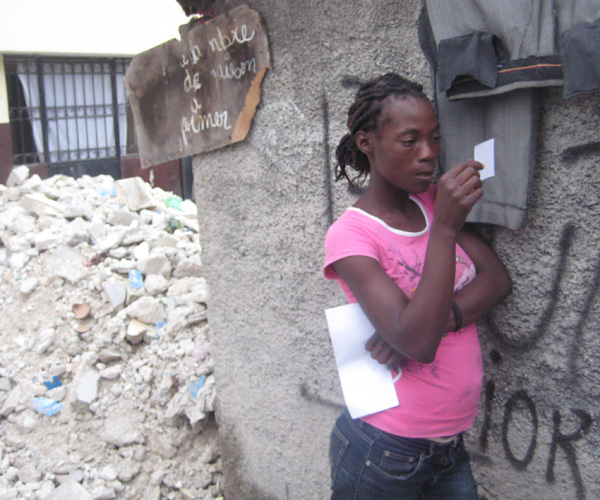
Woodline Augustine lost her three year-old son Jamley in the earthquake. (Photo by Alice Speri)
Mariage Haïtien
Today I went to my first wedding in Haiti.
In the unfinished basement of a church, with children sweating in suits that didn’t fit them in spite of the half dozen fans that blended in with the keyboard soundtrack. I have always loved it when in movies set in a different epoch the priest celebrating a wedding asks the audience if anyone would come forward with a reason why the union shouldn’t happen. This one asked it at least three times, at different points in the ceremony. (Although the wedding I attended my very first day in Benin holds the record — the groom would literally refuse to swear loyalty and fidelity. Men.)
The best part was the sermon though. It was the most sexually explicit thing I ever heard come out of a preacher’s mouth (and any adult really). The guy seemed to have taken inspiration from When Harry Met Sally and went on for twenty minutes describing, almost mimicking, foreplay and beyond, without even gracing us all with the use of metaphor or euphemism.
But regardless of my shameless blushing, love and sex are beautiful things. And they are still very much all over Haiti, thankfully.




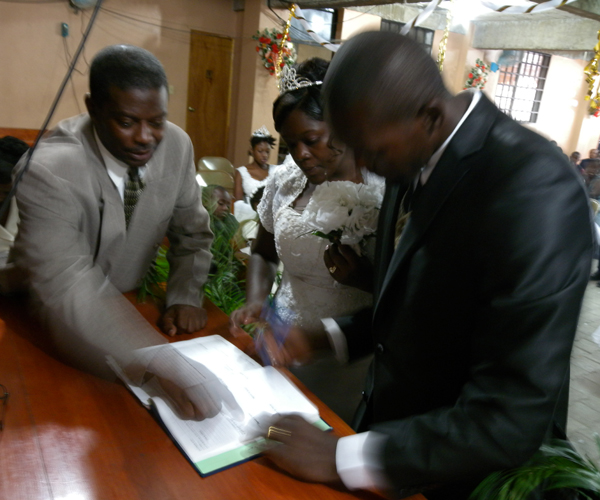

Border Crossing
Before coming to Haiti, in March, I had interviewed a Human Rights Watch researcher, in a Park Slope cafe’. She had just come back from a surveillance trip to the booming refugee camps of Port-au-Prince and the contrast between our conversation and the quiet Sunday morning, Brooklyn setting couldn’t feel more estranging. She also threw me a lede for a story, which on that first trip I had no time to pursue.
She told me she had driven from Santo Domingo to Port-au-Prince, as most were doing before commercial flights were resumed. She had arrived at the border after-hours and found a loosely barred gate, which local kids promptly swung open at her arrival. Her team stopped to make sure their papers were in order, but in the hour or so she spent there, she saw truck after truck driving in and out of Haiti, with no one stopping them. At the time when the Idaho missionaries smuggling presumed orphans into the Dominican Republic was all over the news and had put all adoptions from Haiti on hold, that detail of an informal border, which I had often come across in other parts of the world, felt disturbing.
I had also been reading about Haiti being the preferred transit point for massive shipments of cocaine from South America to the United States and Europe, and at a time of pure anarchy in the country, I had assumed at least the borders would be secured. Isn’t that what everyone is rushing to do these days? Secure misery and trouble out of our borders? (Yes, sarcasm intended.)
I didn’t make it to the border in March, but I did last week. Natacha, in one of her beautiful moments of Haitian spontaneity, picked me up at 6pm on Tuesday and told me we were driving to the Dominican Republic. That evening. A friend of hers was picking up his girlfriend and a few friends, who had been living in Santo Domingo since the earthquake, and Natacha wanted to go meet the Dominican engineers in charge of her school’s reconstruction. Of course, I went.
The road there took us through the poor but beautiful Haitian countryside. By the lakes and mountains that give the sights beyond Port-au-Prince the constant aura of an Olympus of sort. A place for gods, not humans.
Driving on an increasingly bumpy road, through a few rain showers and into the night, it felt as if the road itself was a stage, and the huts and villages and stranded farmers on the sides, lines of spectators, sitting and waiting for the show, their eyes always to the road, like figurines in a nativity scene. Then it got too dark to see anything, and we repeatedly took the wrong turn as the road lost all resemblance to an actual road.
By the time we made it to the border it was almost 11pm. Nobody stopped us as we drove through, with the exception of a UN van driving by that slowed down as if to show interest, and then moved past us.
When we reached the Dominican border, a closed green gate, we parked our car. The Dominican engineers on the other side pointed us to the right: the gate was literally just a gate, standing in between nothing. We walked a few feet around it, and into the Dominican Republic.
(When I went back the following day, a Dominican official did ask me for my passport and seemed to look for a stamp of entry into the DR. He didn’t find it, shrugged his shoulders, and let me go through anyway.)
Now, I am no fan of borders, really. I have more or less legally circumvented a few and I once made it into the very state of California – from Tijuana of all places – without having my papers in order. I hate walls, wherever they stand, and don’t get me started on what I think about immigration.
Crossing borders illegally, overnight, felt quite exhilarating for a moment. But I wasn’t smuggling drugs or children. My friend Ben sent me a link to this story, today, just to remind me how my bravado seems so stupid when you actually remember what’s wrong with an unguarded border in Haiti.
“Child predators descend on quake-stricken Haiti seeking sex slaves”
Just a highlight:
“Since we’ve been there and since we’ve been back, there have been groups of children found at the border in so-called safe houses,” she said.
“People put children into these homes and then wait till darkness to get them across the border. It’s happening.”
I have no doubt this is happening. It’s that easy.
—
Across the border, we didn’t meet any child predators, but two friendly Dominican engineers I had already met in March, a lovely plantain-based dinner and a deserted square where the engineers drunk their whiskey and reminisced of their communist youths.
Elias Pina, in the Dominican Republic, is one of those places like Timbouctou, which seem to exist only in the fantasy worlds of travelers.
By day or by night, Elias Pina felt like one of those small Caribbean towns in the novels of Garcia Marquez that even he would only manage to describe as ‘sleepy.’ One of those towns where if you don’t die of boredom you become a poet.
Yet looking at Natacha’s excitement I felt the weight of my New York bias in my perception of this place. For someone coming from ravaged Port-au-Prince, Elias Pina was all that Haiti could be and wasn’t. Clean, safe, dignified.
Haitians in any of Port-au-Prince’s refugee camps would have probably craved a place like this. Paradise is such a relative concept.
“I don’t even understand why we have to be two separate countries,” Natacha told me. She taught herself Spanish and escapes to Santo Domingo whenever she gets a chance.
“Why can’t we be like this in Haiti?”
Back to school
After closing for over three months, Haitian public schools finally reopened in April, alleviating some of the boredom and sense of suspended existence that, after the trauma, settled into the lives of most Haitians, and children more than everyone else.
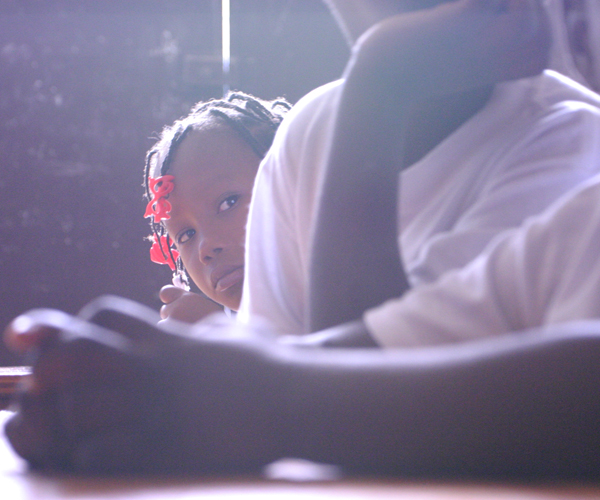
The first children to come back to Natacha's school after the earthquake, March 2010. (Photo by Alice Speri)
As many schools were destroyed in the earthquake, classrooms are now being run under tends, in open-air areas, roofless churches or wherever there is space – a rare commodity in a city already cramped before and where now people are sharing space with piles of rubble and perilous buildings.
Natacha actually reopened her school much before government schools did. The main building crumbled like a sand castle, but all the kids had left school already and nobody was injured. Three of the school’s 200 children died in their homes, a relative miracle if you look at the girls’ college two blocks away, that collapsed killing almost all the 400 students inside.
Only weeks later Natacha’s school was running again, in the building where she was running an orphanage. When I was here in March I saw the first kids coming back for school, excited as kids always are on the first days of school, kissing their teachers on the cheeks, their red uniforms perfectly ironed and the girls’ braids tightened in bows and ribbons, as if they were going to a wedding.
When I came back last week, all children and teachers had returned, and the orphanage building, with a few cracked walls, was fitting many more kids than it was ever designed to. Teachers had turned hallways and the narrow courtyard into improvised classrooms, separated from one another only with curtains.
Life claimed Port-au-Prince’s streets back with all of its loud, excited and undefeated vivacity, and the quickest way of realizing just how alive this place is, is spending time with Haitian children. Traumatized and confused as they may still be, they are always children, and the ones that will put this country back on its feet.
The girl in this video seemed to think I wasn’t convincing enough as a plain blanche and thought I was Dominican. So she started speaking her own version of Spanish to me.
She then directed a group of friends into improvising Creole covers of pop hits. My internet connection is painfully slow, I’ll upload this soon. (I’d like to think someone is trying to forcibly educate me to the value of patience and the Caribbean pace of life. I shall yield.)
A few hours later — Here’s more cuteness.
Natacha’s school and orphanage – MEVA – are sponsored by German NGO HaitiCare, which was founded by Natacha’s ‘long distance’ adoptive father.
Natacha
I first met Natacha in March, when I was desperately looking for a place to stay in Port-au-Prince. With some 1.5 million Haitians living under plastic sheets, bedsheets, and the lucky ones, tents, worrying about my own accommodation seemed plain wrong at the time. Even so, it was one of the biggest challenges for anyone traveling to Haiti at the time. The couple hotels that hadn’t collapsed in the January earthquake were charging hundreds of dollars a night, not exactly a poor freelancer’s budget. I also have made it somewhat of a point to never stay at hotels, anywhere I go. I contacted a few other journalists but everyone was dealing with the same problem. The AP bureau was destroyed in the quake and when I met with AP reporters in Port-au-Prince they were still looking for a place to stay.
So I turned to couchsurfing, the best thing that happened to world travelers since the invention of backpacks. I had couchsurfed across West Africa, among other places, and hosted travelers wherever I happened to have a home at any given time. Couchsurfing is something of a modern hitchiking – I love everything about it and the values it stands for.
In Haiti, it got me a roof to sleep under, but most importantly, it took me to Natacha.
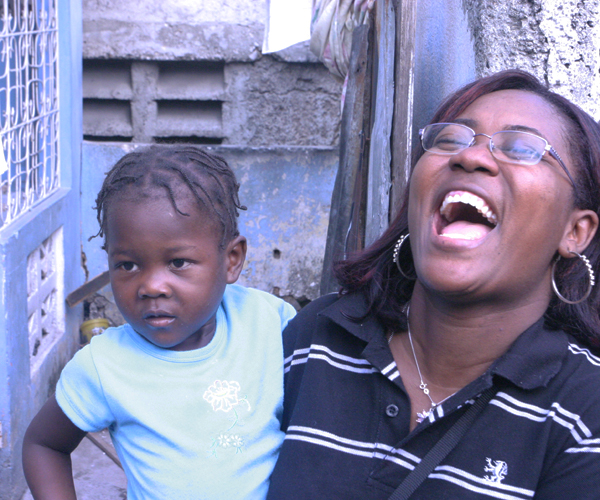
Natacha Marseille, March 2010. (Photo by Alice Speri)
Quite simply, Natacha is one of the most extraordinary people I have ever met. After the earthquake we all heard a lot of phrases thrown around about Haiti, often from people with little understanding of this country’s complexity. Some were true. One of them, “Haitian resilience” described the Haitian people like no other. Natacha embodies just that, the Haitian resilience in all of its beauty and power.
Below is something I wrote about her, after the first weeks we spent together.
Natacha grew up in a SOS Children’s Village for orphan kids. She is now 29, fluent in five languages and the director of a school and orphanage in Port-au-Prince.
Less than two months after the earthquake destroyed her school and while much of the rubble in Port-au-Prince laid untouched, Natacha had hired some 300 women and men from the lower-income neighborhood of Carrefour Feuilles, where the school was, to clear the debris away and make room for a new, more beautiful school. For five days, a human chain of people sang songs and laughed as they passed down the line bucket after bucket of rocks and rubble – a glimpse of the Haitian spirit we rarely see and from which those talking ambitiously of reconstruction need to draw lessons.
Standing on a roof that hadn’t collapsed, Natacha joked with the workers, while discussing her reconstruction plan with two engineers – explaining to them “her dream,” as she always calls it. She pointed to collapsed homes in a neighborhood that even before the earthquake was among Port-au-Prince’s poorest, then at an abandoned stretch of land turned dump. But her eyes didn’t see the pigs and dogs picking through the trash, they saw the parks and market areas she is going to build here, the new homes that will make this three-block stretch of Haiti into an example of what the entire country could be.
Natacha is not an architect; she talks sometimes unrealistically about the way funding works. One, too, does not need to have a skeptical nature to see the challenges and roadblocks on the way to realizing her vision. Yet Natacha has a way of making things happen that few with a perfectly tested plan can match. She has a way of talking to vendors on the street explaining the changes taking place in their neighborhood that far too many aid organizations in Haiti lack.
Weeks after the earthquake, Natacha’s house was home to me, but also friends, children, volunteer doctors and other stranded travelers. Natacha never says no. She jokes about the impossible and then goes ahead and makes it happen.

Natacha in Carrefour Feuilles, March 2010. (Photo by Alice Speri)

Natacha on the site of her destroyed school, March 2010. (Photo by Alice Speri)
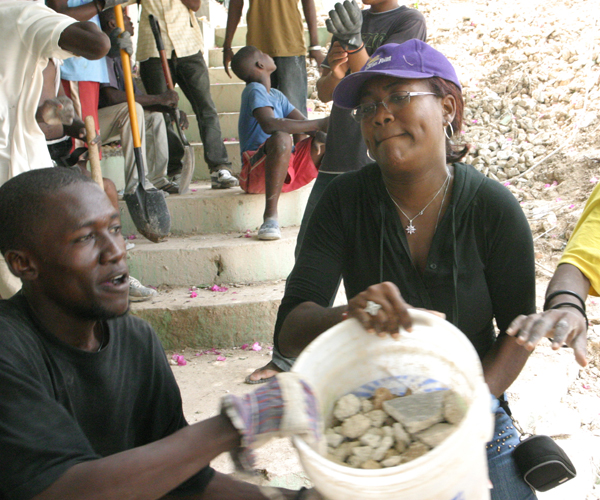
Clearing the rubble, one bucket at the time. March, 2010. (Photo by Alice Speri)
Return to Haiti
Last Monday I moved from New York to Port-au-Prince, Haiti with a few books, a camera and my laptop. I walked out the Toussaint Louverture airport into the dusty and crowded road, two months after my first trip here and almost six months after a devastating earthquake shattered the city and the lives of hundreds of thousands Haitians.

Champs de Mars, Port-au-Prince, March 2010. (Photo by Alice Speri)
As my friend Jean Baptiste drove me to Natacha’s home, in Musseau, I watched Port-au-Prince move past my window, remembering my first time on this same road. At that time it had looked the way I had imagined Hiroshima must have. This time it didn’t. Rubble still filled holes that had once been buildings, but the piles of debris seemed a little more orderly, as if someone had combed them together and paved passages around them. People hanging around the kiosks that lined the Route de Delmas looked more bored than lost, while the frantic street activity around them reminded me more of any busy junction in many of this world’s overcrowded cities than it did the desperate scene from hell it had looked like a few months ago, when no one knew where to go and everyone took to the streets. The colors looked different, too, and the stores that had reopened for business interrupted the files of abandoned building shells and gray cement blocs with patches of brightness. I couldn’t tell if it was fresh paint, or just the rain, that washed Port-au-Prince of the dust that since the earthquake had been everywhere. I saw less UN military tanks, and wondered where all those that had lost limbs in the earthquake had gone.
In other words, Port-au-Prince felt different. But I wasn’t sure it really was, and for a moment I feared I had just become accustomed to it. It always amazes me how quickly shock and horror turn into routine.
“Are things getting better?” I asked Jean Baptiste, my friend in the Haitian National Police, who liked being assigned to patrol quiet corners of the city, where he can pull out his phone and listen to hip hop hits. K’naan’s “Wavin’ Flag” is the song of the moment, and has made it to his ring tone. I’ve been humming this song since I got here.
When I get older, I will be stronger, they’ll call me freedom.
Jean Baptiste smiled, like he often does, instead than answering. He doesn’t like talking politics, but when I jokingly force him to, he tells me that with disasters, in Haiti, the rich get richer and the poor get poorer. He tells me people are sick of the government and they are sick of MINUSTAH. He asks me not to go to the protests that are happening downtown with increasing frequency (he knows I will), and when I ask him what the alternatives are and what he thinks will happen next he just smiles.